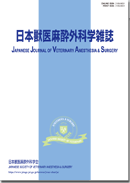We investigated the clinical features and treatment results of 24 cats with mast cell tumors (MCTs), including cutaneous (c-MCT, n=17), splenic (s-MCT, n=2), and simultaneous cutaneous and splenic types (cs-MCT, n=5). Cutaneous lesions were treated by surgical excision or glucocorticoid therapy, and six of seven splenic lesions were treated by splenectomy. Of the 22 cats with c- or cs-MCT, six cats (four with c-MCT, and two with cs-MCT) had one to three distant recurrences (at a skin site distant from the original site) after initial treatment. Of the 31 c-MCTs in these 22 cats, eight were treated with glucocorticoid therapy, which led to complete remission of seven c-MCTs (88%); the other 23 c-MCTs were surgically excised, with only one (4%) recurrence at the surgical site. Although eight of 24 cats (33%) developed recurrent lesions, tumor-related death only occurred in one cat with cs-MCT (4%) during the follow-up period (range 30 to 2,364 days, median 537 days). These results suggest that both surgery and glucocorticoid therapy were effective in local control of c-MCTs, and that long-term survival can be expected, even in cats with s-MCTs who have undergone splenectomy.
View full abstract
